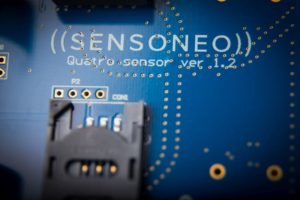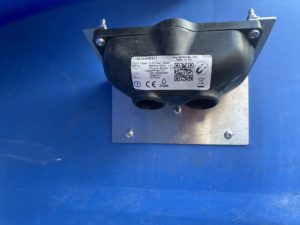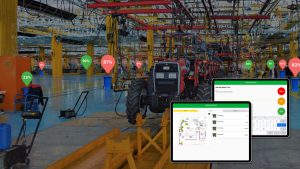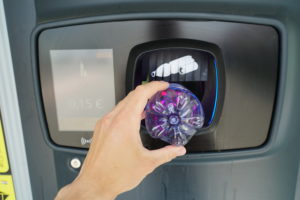Frequently Asked Questions
About Sensoneo
About Sensors
About Factory Waste Management
About DRS & Take-Back System

FAQ – About Sensoneo
What services does your company offer in the field of waste management?
Sensoneo offers a range of smart waste management services, including both hardware and software. In short, we offer waste collection management solutions for cities and waste collectors, waste management solutions for factories and the manufacturing industry, reverse logistics solutions for EPR operators, as well as the nationwide system implementation of deposit return schemes.
When was Sensoneo founded?
The company was founded in 2017, by Andrea Basilova and Martin Basila, who is currently also the CEO of Sensoneo.
Where is the company located?
Sensoneo HQ is located in Bratislava, the capital of Slovakia, a member state of the European Union. Sensoneo US office is located in Scottsdale, Arizona.
In which countries is your company active?
Our company is active in more than 80 countries around the world. We have a strong presence in Europe, North America, and the MENA region, and are continually expanding our operations to new markets.
How many employees work at Sensoneo?
Currently, there are more than 80 employees working at Sensoneo. The majority of our people work from Bratislava, Slovakia, with an active branch in the USA and a business developer operating directly in the Middle East.
What makes your company’s approach to waste management unique?
Sensoneo places a strong emphasis on research and development, which allows us to stay at the forefront of innovation in the field of waste management. Our in-house software and hardware developers are constantly working to develop new technologies and processes that enable us to more effectively and efficiently manage waste, while also reducing environmental impact.
Our customers highly value the fact that we are providing an end-to-end complete solution combining software and hardware and are thus taking full responsibility for our products. If any issues occur, our clients do not have to deal with two different vendors.
We are a stable and reliable partner who started as a startup, and we still have the anything-is-possible mindset. We find solutions also for problems that seem impossible to solve and deliver on competitive timelines.
What is the advantage of smart waste management?
Smart waste management refers to the use of technology and data analytics to improve the efficiency and effectiveness of waste collection and disposal. Some of the advantages of this approach include:
- Optimized routes: By using fill-level monitoring sensors and routing algorithms, waste collection vehicles can be routed dynamically and in the most efficient way possible, reducing the distance traveled and fuel consumption. This can help to decrease greenhouse gas emissions and save on costs.
- Saving costs and time: By optimizing routes and increasing the efficiency of waste collection, smart waste management can significantly help to save time and reduce costs.
- Sustainability: Smart waste management can help to reduce the environmental impact of waste disposal, as it can help to reduce the amount of waste that ends up in landfills and increase the recycling rate.
- Data-driven approach: Smart waste management relies on data analytics to make informed decisions about waste collection and disposal. This data-driven approach allows for a more efficient and effective waste management system.
- Transparency: Smart waste management systems often involve the use of sensors and other technologies that can provide real-time data on waste levels and collection rates. This can help to improve transparency and accountability in the waste management process.
- Improved efficiency: By using technology to optimize routes and increase the efficiency of waste collection, smart waste management can help to improve the overall efficiency of the waste management system.
Overall, the main advantage of smart waste management is that it can help to improve the efficiency and effectiveness of waste collection and disposal, leading to a variety of benefits including reduced greenhouse gas emissions, cost savings, increased sustainability, and improved efficiency.
Is the company growing?
Yes, Sensoneo is definitely growing and expanding. We are constantly scaling our operations and exploring new markets in order to increase our reach and impact. As a result of this growth, we have seen an increase in our revenues and have received new investments. We are committed to using these resources to further enhance and expand our waste management services, while also maintaining our commitment to sustainability and responsible business practices. Overall, we are excited about the growth and development opportunities that lie ahead for our company.
Did Sensoneo win any awards in recent years?
Yes, Sensoneo holds several prestigious recognitions and awards. To mention only a few of them, Sensoneo became the winner of the Innovation World Cup Series’ Smart Territories Challenge in 2019 and it was also recognized as one of the top 3 CEE scale-ups in the same year. Sensoneo is also responsible for the first commercial Narrowband IoT deployment in the United States. You can find the overview of our biggest achievements here.

FAQ – About sensors
What is a bin sensor and how does it work?
An ultrasonic bin level sensor is a device that is used to measure the level of waste or other materials in a bin or a container. It works by emitting ultrasonic waves (i.e., sound waves with a frequency higher than the upper limit of human hearing) and measuring the time it takes for these waves to bounce back after hitting the surface of the waste material. Based on the time it takes for the waves to bounce back, the sensor can calculate the distance to the waste material and determine the level of waste in the bin.
Ultrasonic bin level sensors are commonly used in waste management systems to monitor the fill levels of bins and containers, allowing waste collection companies to optimize their routes and schedules. They can also be used in other applications, such as inventory management and process control, to measure the levels of materials in tanks, hoppers, and other containers. Another example is water level monitoring: our sensors are monitoring the underground water levels in manholes in several villages in Norway.
Who will deploy and configure the sensors?
The deployment of our sensors is very easy and user-friendly and can be conducted by customers themselves. However, Sensoneo is operating through the network of certified reseller partners which can act as system integrators for large-scale deployments in different countries all over the world.
Which IoT networks do the sensors support?
Based on the type of our sensor, they support connectivity with LoRaWAN, Sigfox, NB-IoT, CAT-M1 or GPRS.
How long will the sensor batteries survive and what happens afterward?
Batteries of our sensors have a lifespan of approximately 5 years and they are easily replaceable at the end of their lifespan.
What is the lifespan of the sensors and their guarantee?
The minimum warranty for the sensors as stated in the contract is 1 year. The lifespan of sensors is very individual, based on the frequency of data messages, as well as the temperature conditions, but the average duration of our sensors is 4-5 years.
Why are Sensoneo sensors better than the ones from the competitors?
Our ultrasonic bin sensors offer a number of competitive advantages, including:
- Durability: These sensors are very robust, which means they have a longer lifespan and can withstand harsh environmental conditions.
- Scalability: These sensors can be deployed on a large scale, making them suitable for use in cities or municipalities with a large number of waste bins.
- Ease of use: These sensors are easy to install and use, which makes them accessible to a wide range of customers, not only big cities.
- Versatility: These sensors can be used in a variety of environments, monitoring different types of waste in various types of containers and bins.
- Connectivity: These sensors can transmit data over different IoT networks, allowing for real-time monitoring and analysis of waste levels.
- Community engagement: By using these sensors, cities and municipalities can engage their citizens in the waste management process and help promote a more sustainable waste management policy.
Read more about the competitive advantages here.
What is the price of one piece of the sensor?
The price of an ultrasonic bin-level sensor can vary significantly depending on a number of factors, including the specific features of the sensor, the number of sensors being purchased, and the level of integration with other systems (such as IoT connectivity).
In order to get a more accurate estimate of the price for a particular sensor, it is best to contact us directly and provide us with details about your specific requirements and needs. Our business development managers will be able to provide you with a customized quote based on your specific requirements.

FAQ – About Factory Waste Management
What does the Factory Waste Management solution do?
The solution offers remote control over the fullness of the bins in factories and facilities through automatic notification (sensors) or manual notification (buttons). Thus, just-in-time waste collection is guaranteed and the production flow is not disrupted. A collection planning engine and driver app based on the factory floor plan ensure more efficient waste management within the factory.
What benefits does it bring to factories?
Simply said – our solution brings the waste in factories under control, automating and digitizing the waste collection process meeting the specific needs of factories, and offering the data for optimization, for example minimizing FTEs or time required for collection.
How long does it take to implement the solution?
We require certain information to set up the operation such as factory layout and bin positions to feed into Smart Waste Management System. Once the system perfectly knows your operations and schedules, it is ready to manage your waste collection. The solution is simple to integrate and you can have it up and running in just 7 working days. Based on the level of customization, the implementation can naturally take longer.

FAQ – About DRS & Take-Back System
In which countries is Sensoneo a DRS system integrator?
Sensoneo implemented Deposit Return System in Slovakia and Malta, making us the first and only DRS integrator in two EU countries.
What does it involve?
Sensoneo’s DRS system enables DRS scheme stakeholders to make the most out of the post-consumer recycling potential as it optimizes and automates operations, drives efficiency, facilitates transparency, and introduces an easy-to-use approach. From the process point of view, Sensoneo’s DRS solution covers all critical pillars of the implementation process and operation itself: ongoing project management, workshops, configuration, customization, data migration, training, testing, go-live phase, and a service desk. Sensoneo’s DRS system works as the backbone of the whole system and includes modules for every activity involved in the preparation, operation, and reporting. The modules reflect specific requirements a needs, and completely fulfill all the obligations of each stakeholder.
What is a take-back system?
A take-back system is a system that is designed to allow consumers to return used products to the manufacturer or retailer for proper disposal or recycling. This is typically done as part of an effort to promote the circular economy and reduce waste. In a circular economy, resources are used efficiently and waste is minimized through the use of closed-loop systems that allow for the reuse or repurposing of materials.
These systems can be operated by the manufacturer, retailer, or a third party, and they may involve the use of drop-off points, mail-back programs, or other methods of collecting used products.
Who is Sensoneo biggest Take-Back System Customer?
Nationwide WEEE collector in Czech Republic ASEKOL with more than 22 000 collection points and 44,5 tonnes of e-waste collected in 2021. Read about the reference here.
Which other waste streams are suitable for take-back system?
Take-back systems can be used for a variety of products, including electronics, batteries, packaging, and other household goods. Actually, every waste with a big value in the material that it is made from, which can later be recycled ensuring the strengthening of the circular economy. Other examples can be old tires, ceramics, metal, or textiles.
Do you still have some additional questions?
Please fill in your contact information and ask anything you would like to know. We will contact you via email to give you the relevant answers. Your contact information will not be used for any other purpose.



